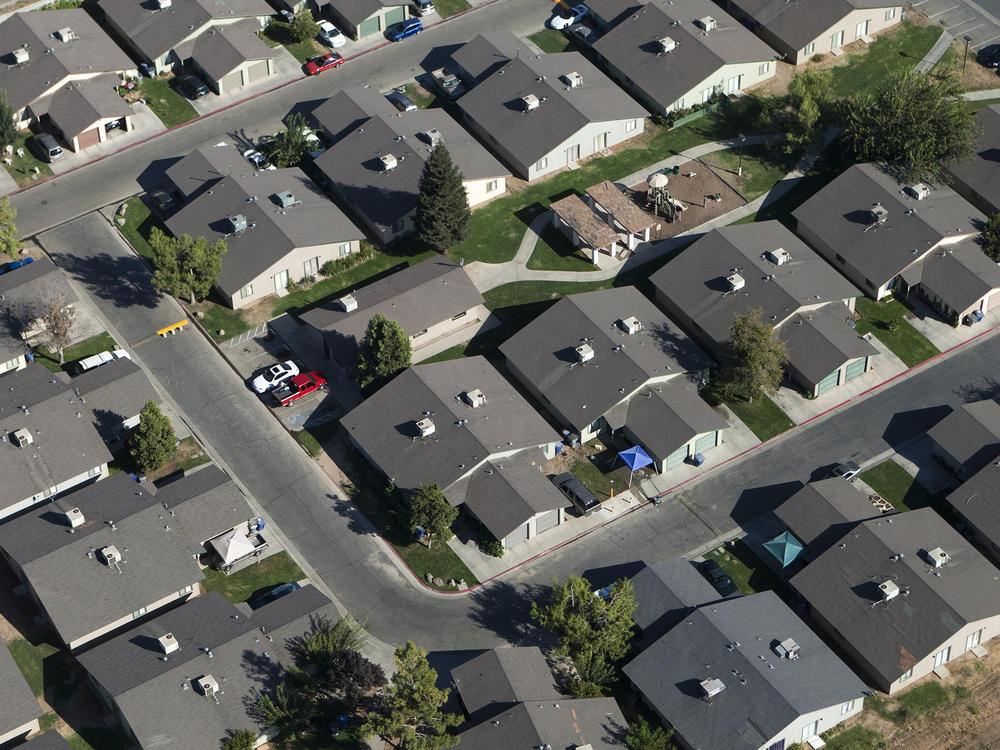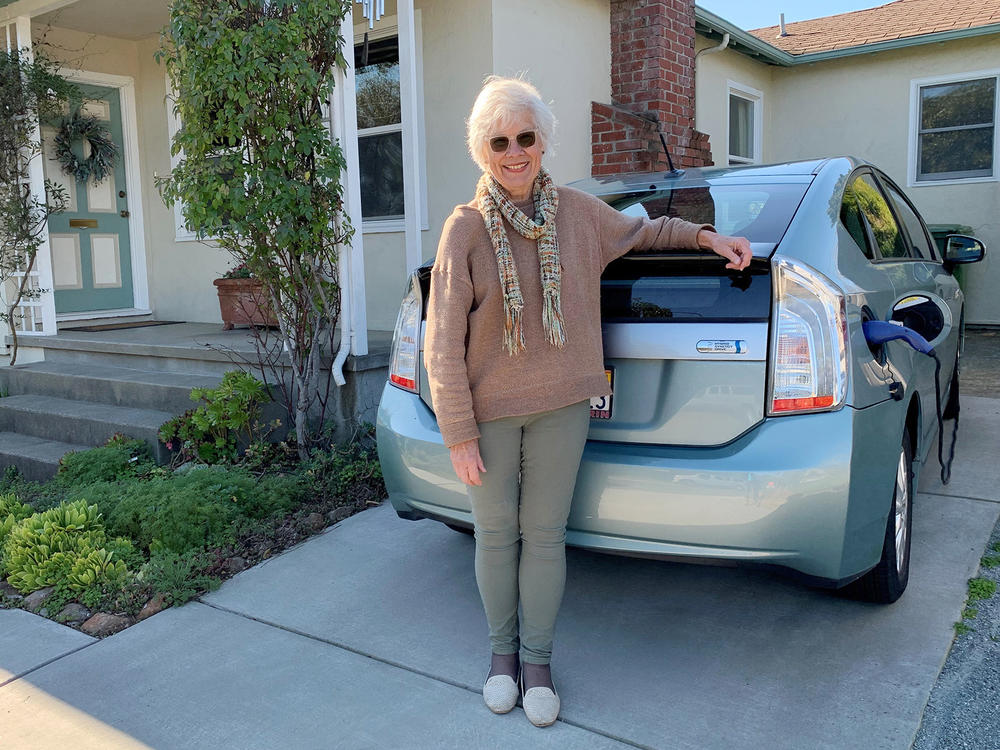Section Branding
Header Content
Why Sprawl Could Be The Next Big Climate Change Battle
Primary Content
President Trump is attacking Democrats on a new front: suburbia.
"They want to eliminate single-family zoning, bringing who knows into your suburbs," Trump said on a July campaign call.
While it's unclear whether Trump's veiled appeal to racial anxieties will help his poll numbers, the focus on single-family homes has touched on a contentious debate in a growing number of communities. Around the country, cities and states are grappling with how zoning rules have deeply codified racial inequity and exacerbated climate change.
Local codes have ensured that suburban homes with a two-car garage dominate the American landscape, but those rules originally were often directly linked to racial discrimination. Single-family zoning was passed in some cities to ensure racial segregation. The deeds of some houses specified that only white buyers could purchase them.
As sprawl became the default, it increased the reliance on cars. Today, super-commuters who live hours from their jobs are driving up carbon emissions. Experts say tackling climate change will mean reshaping neighborhoods with a new focus on public transit, biking and walkability.
Looking to address the legacy of racism and the threat of climate change, some communities are remaking their zoning laws. Minneapolis and Oregon recently passed new "upzoning" codes allowing duplexes or triplexes in areas once zoned as single-family and encouraging denser development around transit and jobs.
But in California, resistance to denser zoning has been fierce. After failing to pass measures three times, lawmakers are now making a fourth attempt to tackle zoning in a state with both a severe housing crisis and an ambitious climate goal.
"I think the lesson for the rest of the country is that even in California's liberal suburban enclaves with Black Lives Matter signs everywhere, residents and local elected officials are still hostile to opening their communities up to housing that would bring people with diverse backgrounds and incomes," says Ethan Elkind, director of the climate program at University of California, Berkeley's law school.
NIMBY vs. YIMBY
In California, attempts to overhaul single-family zoning have fallen short. Often it's because they failed to win over Democrats, even those who supported the state's groundbreaking goals for boosting renewable energy and cutting carbon emissions.
"I think climate change is one of the real serious issues that we have to deal with," says Susan Kirsch, a community organizer in Mill Valley, Calif. "But I don't think we need to be forcing draconian measures, taking away local control and local preferences, to be able to solve that problem."
In Kirsch's driveway, an electric Toyota Prius is plugged into a charger. Solar panels cover her roof. Single-family homes like hers make up much of Mill Valley, a city located about half an hour north of San Francisco, where the median price is about $1.5 million.
"There's a lot of people who are master gardeners and people committed to the environment and are taking care of the environment," she says. "A birthplace for recycling and eliminating plastic straws."
Kirsch's neighborhood is exactly the kind targeted for zoning change. She lives in a walkable area within a quarter-mile of a bus stop and close to a bank and grocery store. Right now, city zoning only allows single-family homes there.
In a state bill proposed last year, single-family zoning in places such as Mill Valley would be opened up to duplexes, triplexes and fourplexes. In larger counties, areas within a quarter-mile of transit and jobs would have no limit on the number of units in the hope of boosting the housing supply and encouraging public transit use. It was lawmakers' second attempt after a previous bill failed.
"Knowing that any of the neighbors could do that, there's a sense of the incredible impact of that kind of change in this community," Kirsch says.
So Kirsch helped organize efforts to defeat the bills, which earned her the label NIMBY, aka "not in my backyard."
"Actually, I keep trying to change the label to be a bit of a badge of honor in terms of stewardship," she says.
In January, lawmakers debated on the floor of the state Senate. Some Democrats opposed the bill over concerns about gentrification and affordable housing. But other Democrats saw it as an attack against single-family homes and local control. The bill failed by three votes.
This summer, legislators are making a fourth attempt with a new package of housing bills.
"The climate discussion did get attention, but not as much as it deserved," says state Sen. Scott Wiener, who introduced the bill. "Leaving the cities to their own devices hasn't worked. They've given us a 3.5 million home shortage and so we need to rebalance the state vs. local decision-making here."
Driving up emissions
Overall, carbon emissions are declining in California, largely thanks to the rise of renewable energy such as solar power. But emissions from transportation are still going up, a clear obstacle to the state's goal of becoming carbon neutral by 2045.
"If you really want to address the climate problem, we're going to need our neighborhoods to be built in a different way," says Elkind. "We just simply cannot meet our near-term and certainly our long-term climate goals unless we address the land use question."
Studies show that residents of large cities have lower carbon footprints, generally. Residents in suburbs near a large city can have 50% higher transportation emissions than city residents.
Elkind sees a disconnect in California. Cities may consider themselves environmentally progressive, but their zoning bans duplexes or triplexes in up to 98% of residential areas. (See how various Bay Area cities are zoned in these UC Berkeley maps).
"Those people who would have lived in that home are not just going to evaporate from Earth," he says. "They're just going to choose a different home. And for all the electric miles you're putting on your Toyota Prius or whatever it is, you're now forcing those residents to have to drive 30, 40, 50 miles in a gas vehicle."
Legacy of discrimination
What California hasn't done, other places have. Last year, Oregon passed a law to allow higher density housing statewide.
Before that, prior to the death of George Floyd and racial justice protests, Minneapolis was the first major city to tackle single-family zoning. (Some cities have also passed accessory dwelling unit rules to encourage building "granny flats" in backyards.)
The new zoning rules in Minneapolis allow duplexes and triplexes in areas once limited to single-family homes. Zoning for larger residential buildings is concentrated around public transit and walkable neighborhoods.
"This was a very controversial planning process," says Lisa Bender, president of the Minneapolis City Council. "We had competing lawn signs messages. We had lots of media coverage."
The city recognized that single-family zoning was preserving land use patterns with a discriminatory past. Some homes in single-family neighborhoods once had racial covenants in their deeds, which specified that only white residents could buy the property.
African American residents were displaced into neighborhoods that were then subject to "redlining." That meant banks often wouldn't provide mortgages to residents there, preventing Black communities from building intergenerational wealth through homeownership.
"The conditions that people are living with today in communities of color, those were locked in by a housing policy and what it locked in, usually, is poverty and pollution," says Alvaro Sanchez, director of environmental equity with the Greenlining Institute, a racial and economic justice group in Oakland, Calif.
Many communities of color bear a greater burden of pollution because they're located next to freeways or heavy industry. Green spaces and parks are often absent or neglected, causing those neighborhoods to experience even hotter temperatures during heat waves. Sanchez says racial discrimination is still an essential problem in housing policy, but often, it's not discussed openly.
"I think that there's undertones in, well, we don't want our neighborhoods to change," says Sanchez. "And to me, I'm left with a question mark. What's the kind of change you don't want to come to your neighborhood? What's the expectation that if you densify, a certain demographic is going to come to your neighborhood?"
Eliminating single-family zoning alone won't automatically lead to greater racial equity, he says. Increasing development runs the risk of gentrification and displacement, so housing justice advocates say there needs to be strong affordable housing policies and tenant protections, as well as ensuring that communities of color are directly part of the planning process.
"How we make these decisions is really key," says Tiffany Eng of the California Environmental Justice Alliance. "We have to ask ourselves who is benefiting from this housing? Who is losing? And what communities are centered?"
One of the toughest things in the Minneapolis debate, Bender says, was helping residents picture how their neighborhoods could change. Denser zoning challenges the American ideal of a big suburban home.
Bender says: "When you start to take on those kinds of ingrained assumptions that somehow that's better, that's where we really start to open up our minds to the possibility that our city can evolve to fit future needs of all of our residents."
Copyright 2020 NPR. To see more, visit https://www.npr.org.


